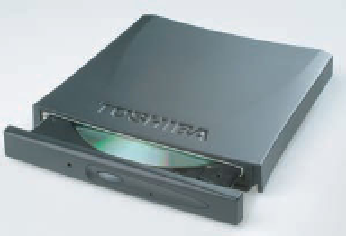Information Technology Reference
In-Depth Information
Virtual Tape
Virtual tape
is a storage technology that manages less frequently needed data so that it appears
to be stored entirely on tape cartridges, although some parts might actually be located on
faster hard disks. The software associated with a virtual tape system is sometimes called a
virtual tape server
. Virtual tape can be used with a sophisticated storage-management system
that moves data to slower but less costly forms of storage media as people use the data less
often. Virtual tape technology can decrease data access time, lower the total cost of ownership,
and reduce the amount of floor space consumed by tape operations. IBM and Storage Tech-
nology are well-established vendors of virtual tape systems. One organization that uses a
virtual tape system is the Girl Scouts of the USA, which operates a major data center that
holds data on 4 million active members of the organization. The amount of data is roughly
half a terabyte but is expected to grow at a rate of 25 percent per year as the length of time
that data is kept is expanded from ten years to indefinite. The organization uses an REO
9500D virtual tape library from Overland Storage Inc. at a cost of $65,400 for 3.75 terabytes
of storage capacity.
29
virtual tape
A storage device that manages less
frequently needed data so that it
appears to be stored entirely on tape
cartridges, although some parts of it
might actually be located on faster
hard disks.
Optical Discs
Another type of secondary storage medium is the
optical disc
. An optical disc is simply a
rigid disk of plastic onto which data is recorded by special lasers that physically burn pits in
the disk. Data is directly accessed from the disc by an optical disc device, which operates
much like a stereo's compact disc player. This optical disc device uses a low-power laser that
measures the difference in reflected light caused by a pit (or lack thereof) on the disc.
A common optical disc is the
compact disc read-only memory (CD-ROM)
with a storage
capacity of 740 MB of data. After data is recorded on a CD-ROM, it cannot be modified—
the disc is “read-only.” A CD burner, the informal name for a CD recorder, is a device that
can record data to a compact disc.
CD-recordable (CD-R)
and
CD-rewritable (CD-RW)
are
the two most common types of drives that can write CDs, either once (in the case of CD-R)
or repeatedly (in the case of CD-RW). CD-rewritable (CD-RW) technology allows PC users
to back up data on CDs.
optical disc
A rigid disc of plastic onto which data
is recorded by special lasers that
physically burn pits in the disc.
compact disc read-only
memory (CD-ROM)
A common form of optical disc on
which data, once it has been
recorded, cannot be modified.
Digital Video Disc
A
digital video disc (DVD)
looks like a CD but can store about 135 minutes of digital video
or several gigabytes of data (see Figure 3.8). Software, video games, and movies are often
stored or distributed on DVDs. At a data transfer rate of 1.352 MB/second, the access speed
of a DVD drive is faster than that of the typical CD-ROM drive.
DVDs have replaced recordable and rewritable CD discs (CD-R and CD-RW) as the
preferred format for sharing movies and photos.
Whereas a CD can hold about 740 MB of data, a
single-sided DVD can hold 4.7 GB, with double-
sided DVDs having a capacity of 9.4 GB. Unfortu-
nately, DVD manufacturers haven't agreed on a
recording standard, so several types of recorders and
discs are currently in use. Recordings can be made
on record-once discs (DVD-R and DVD+R) or on
rewritable discs (DVD-RW, DVD+RW, and DVD-
RAM). Not all types of rewritable DVDs are com-
patible with other types.
The Blu-ray high-definition video-disc format based on blue-laser technology stores at
least three times as much data as a DVD now holds. The primary use for this new format is
in home entertainment equipment to store high-definition video, though this format can
also store computer data.
digital video disc (DVD)
A storage medium used to store
digital video or computer data.
Figure 3.8
Digital Video Disc and Player
DVDs look like CDs but have a
greater storage capacity and can
transfer data at a faster rate.
(Source: Courtesy of Toshiba Amer-
ica Information Systems.)
Holographic Disc
Holographic Versatile Disc (HVD)
is an advanced optical disc technology still in the research
stage that would store more data than even the Blu-ray optical disc system. One approach to
HVD records data through the depth of the storage media in three dimensions by splitting


